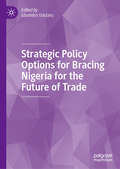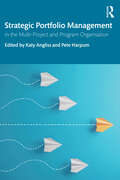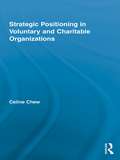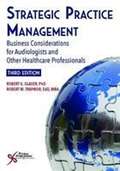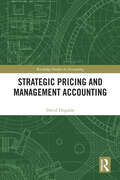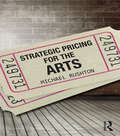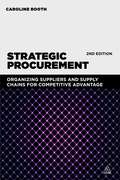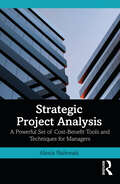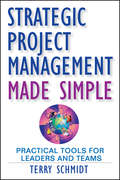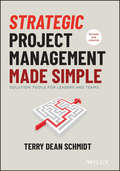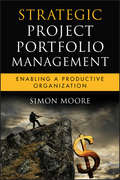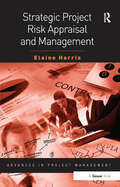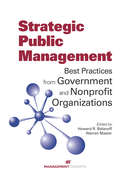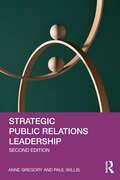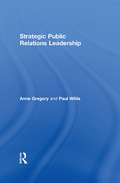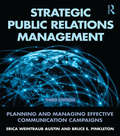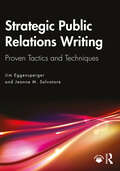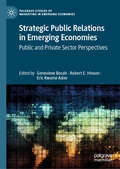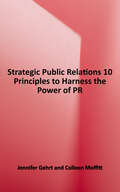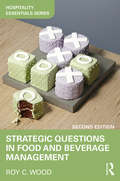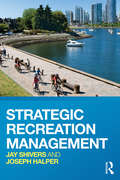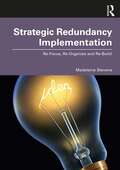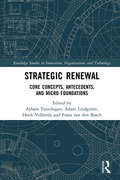- Table View
- List View
Strategic Pokes
by Shombit SenguptaJalebi Management, the first book in Shombit Sengupta's Jalebi Trilogy, compared Indian industry to a jalebi. It showed how it is necessary for organizations to interconnect seamlessly, both internally and externally, so that business can swim smoothly in the sweet syrup of the jalebi. However, the jalebi has a flip side too--its shape is never predictable; but business has to be unsurprising. Being the world's most complex and heterogeneous society how can India find a pattern to get out of the irregular, negative aspects of the jalebi? Strategic Pokes, this second book, is about all the unconstructive areas that business houses in India have to cope with. The book rides through the Indian and European landscape, spanning across history, to explore the perceptible, exciting distinction that customers value. It has examples of how the West is obsessed with embedding the "quality spark" in products and services, which enables them to deftly handle their business and successfully take it around the world. The book reveals how Indian business entangles itself in the jalebi's uneven character, and then with disruptive insights, it looks for a jalebi pattern to exit this maze.
Strategic Policy Options for Bracing Nigeria for the Future of Trade
by Gbadebo OdularuAs the fourth industrial era evolves, the role of blockchain technology, Artificial Intelligence (AI), and machine learning in transforming national commerce cannot be overemphasized, especially with the expansion of e-commerce in Africa. In other words, technological advancement and innovation are becoming essential to many aspects of Nigerian businesses, thereby considerably enhancing trade and productivity. This book provides a primer on the role that digital technology may play in Nigeria’s trade flows, and the implications for enabling an economy-wide deployment of digitization in trade facilitation. This book analyzes the importance of STI’s contributions to the Nigerian economy, focusing on the transition to digital solutions and their potential to significantly increase trade and commerce. Since AfCFTA’s 2018 launch, academic and political responses to the automation of business have increased. Further, business promotion, aid-for-trade, regional integration and trade facilitation issues are at the forefront of business development policy and intellectual discourse in Nigeria. This book details Nigeria’s business opportunities, capacities and challenges with a special interest in sustainably enhancing the nation’s business ecosystem in the digital age. Through the examination of trade facilitation policies, programs, tools, models and technologies, this book demonstrates Nigeria’s need for strategic public-private partnership in digital trade to foster a more sustainable business future.
Strategic Portfolio Management: In the Multi-Project and Program Organisation
by Pete Harpum Katy AnglissThis book provides a powerful insight into strategic portfolio management and its central role in the delivery of organisational strategy, maximisation of value creation, and efficient allocation of resources and capabilities to achieve organisational strategic objectives. The book makes a valuable contribution to the development of thinking on the translation of strategy into actionable work. Whether you are a senior manager building a high-performing strategic portfolio for your organisation or an academic searching for new perspectives on strategy execution through portfolio management, you will find great significance in this book. Twenty-eight chapters in four sections provide multiple perspectives on the topic, with in-depth guidance on organisational design for strategic portfolio management and covering all process, capability, and leadership aspects of strategic portfolio management. The book includes several detailed case studies for the effective deployment of strategic portfolios, bringing together theory and practice for strategic portfolio management. This book is particularly valuable for advanced undergraduate and postgraduate students of project and portfolio management, strategic management, and leadership who are looking to expand their knowledge within the multi-project environment. Highly practical and logical in its structure, it also shows project management professionals how to effectively manage their business portfolios and align this with their business strategy.
Strategic Positioning in Voluntary and Charitable Organizations (Routledge Studies in the Management of Voluntary and Non-Profit Organizations)
by Celine ChewRekindling the critical analysis of the adoption of generic commercial (for-profit) management approaches in the non-profit context, Strategic Positioning in Voluntary and Charitable Organizations reveals that charities are positioning themselves in their evolving external environment in distinctive ways that are not adequately explained by existing positioning theories. Based on original research that examines, for the first time, the usefulness of contemporary theoretical perspectives and interpretations of strategic positioning derived from the existing literature in explaining the positioning activities of charitable organizations within the wider voluntary and non-profit sector. Using a three-stage approach, which involves an exploratory survey and multiple case studies, this book provides: • evidence showing the extent of strategic positioning, the components of a positioning strategy and the process of developing a positioning strategy in charitable organizations that are involved in the provision of public services, • analysis of the key factors that influence the choice of a positioning strategy in the charitable context, and the depiction of these factors in an original integrating model, and • an exploration into the extent to which existing strategy/marketing literature on positioning is applicable in the charitable context. By challenging the adoption of current perspectives on strategic positioning derived from commercial strategy and marketing management literatures into the non-profit and non-market contexts, the author develops a theoretical framework that accounts for the uniqueness of positioning strategy in the non-profit sector. This uniqueness is attributed to the difference in positioning goals, the process of developing a positioning strategy, and the influencing factors on the choice of a positioning strategy in charities compared to commercial organizations. The implications of the findings provide useful lessons for managers of voluntary and charitable organizations in planning and developing their positioning activities, and for other stakeholders, such as policy makers, funders, donors and industry bodies.
Strategic Practice Management: Business Considerations for Audiologists and Other Health Care Professionals
by Robert Glaser Robert TraynorOne of the major skills required for success in practice is to know how to manage a clinic. Strategic Practice Management: Business Considerations for Audiologists and Other Healthcare Professionals, Third Edition is extremely useful for clinicians currently managing their own clinics as well as for the development and teaching of courses in practice management. The first and second editions of this text have been used in university training programs. <p><p> The third edition contains contributions from nine guest chapter authors, six who are new to this text, and all are experts in their field. Their insight provides the reader with an enlightening resource essential to the operational and business management of the practice setting including: developing an appropriate business plan; startup and long term planning; essential legal considerations; fiscal monitoring and methods to assess the ongoing financial health of the practice; reimbursement capture; patient and referral source management; human resource issues including compensation strategies and much more. <p> Dr. Robert Glaser and Dr. Robert Traynor have extensively updated all of the retained chapters with significant improvements to the content, tables, and figures. Comprehensively researched, every effort has been made to provide the most recent and thorough references for further review.
Strategic Pricing and Management Accounting (Routledge Studies in Accounting)
by David DugdaleManagement accountants should have a key role to play in developing and executing pricing strategy and policy. However, their historical focus on costing and operations means that their potential as business partners with marketing and sales professionals is easily overlooked. This book focuses on how management accountants can help key stakeholders in the formulation and execution of pricing policy and, conversely, on showing managers responsible for pricing decisions how they could be helped by management accountants. It equips management accountants with a unique overview of pricing theory, the practical, quantitative techniques they should know and the value they can bring to the pricing function. The book analyses segmentation, value to customer, price-value maps, segmental pricing, product differentiation and dynamic pricing, with traditional economic theory, showing how these ideas have implications for management accountants and the value that they can bring to the business. Differences in customer value have been integral to economic theory for decades and price discrimination, the technique of charging different prices to different customers for the same or similar goods, is well-established. This observation provides the central core of this book. The methods of price discrimination are set out in detail, showing how management accountants can bring their analytical skills to bear in helping executives and pricing professionals take advantage of differences in customer valuation to improve profits. The book provides a thorough overview of the field and offers a good introduction for researchers and students. Equally, the book shows managers, marketers and pricing professionals how management accountants can assist them in delivering better pricing practice.
Strategic Pricing for the Arts
by Michael RushtonWith roughly half of all income for non-profit arts organizations in the United States coming from earned revenue rather than donations and state funding, the issue of pricing is paramount to success in the arts industry, yet pricing is not covered in any existing textbooks. How should prices differ between ordinary and premium seating? How much of a discount in admission should be offered through membership or season subscription? When does it make sense to partner with organizations to offer discounts? Arts managers, whether working in the performing arts, museums or festivals, and whether in the commercial, non-profit, or state sector, need to make informed decisions on the prices they set. This accessible text provides the first concise, practical, non-technical guide for setting prices in the arts industry. Offering a practical introduction to pricing, this book is perfectly suited to students studying arts management /administration as well as new managers working in the creative and cultural industries.
Strategic Priorities in Competitive Environments: Multidimensional Approaches for Business Success (Contributions to Management Science)
by Hasan Dincer Serhat YükselThis book combines various analyses of strategic priorities in a competitive market environment, focusing on the balanced scorecard technique, but also considering customer expectations, organizational requirements, financial outcomes and technological infrastructures. The first part explores the financial impacts and performance measurement of investments, while the second part examines customer demand in a globalized environment. Part three then addresses organizational quality and internal processes, highlighting participatory elements and synergies. Lastly, part four investigates strategic learning in enterprises as a factor for sustainable economic success in times of change and disruption.
Strategic Procurement
by Caroline BoothIn today's challenging business environment a company's success is determined by its ability to utilize all of the assets at its disposal. Yet two assets often neglected by the boardroom are the amount it spends on goods and services and the expertise of the organisation's key suppliers. This highly accessible book will help you understand how to tap into these assets to secure competitive advantage. With application to organisations in all industries across the world, Strategic Procurement details why procurement is critical to successful business performance. It explores the strategic value of procurement to business and the potential for significant cost savings through maximising value from suppliers and third-party spend. Since the first edition of this book, a lot has changed in the world of strategic procurement. While many developments have served to reinforce the business value of good procurement practices, we have also become more acutely aware of the risks associated with poor procurement. On the upside, we have seen an increasing role played by procurement in many recent mega-mergers. On the downside, we only need to look at the supply continuity issues triggered by a string of natural disasters; the reputational issues related to the supply chains of companies such as BP and Apple; and the inadvertent role played by suppliers as the weakest link in cybercrime. The 2nd edition of Strategic Procurement has been thoroughly updated to reflect these developments. There is a whole new chapter on the role of procurement in delivering successful mergers and acquisitions as well as three new chapters exploring the mitigants to a variety of supplier-related risks. In addition, there are expanded sections on corporate responsibility, procurement proficiency, good procurement across the organisation, and new ways of supplier collaboration. The book includes updated real-life case studies taken directly from the author's work in procurement for leading organisations.
Strategic Project Analysis: A Powerful Set of Cost-Benefit Tools and Techniques for Managers
by Alexia NalewaikThe forming, funding, approval, and planning of a project are key factors in its future success or failure. This book explains the use of strategic project analysis, and advocates for a closer relationship between economic analysis and project evaluation and provides real-world examples of major projects that have used this method.The primary quantitative method for decision-making in project selection is cost-benefit analysis. However, the method has well-known flaws and challenges. Using the principles of stakeholders, risk, ethics, and bias, the book presents a rationale for broadening traditional project analysis to include both quantitative and qualitative methods. The identification of sustainability and resilience benefits and hidden value are highlighted as an equally important factor in assessing projects.Written in a clear and accessible style with straightforward maths, this book is invaluable to project owners, decision-makers, and management professionals seeking broader tools to evaluate strategic projects, as well as students of project management.
Strategic Project Management Made Simple: Practical Tools for Leaders and Teams
by Terry SchmidtWhen Fortune Magazine estimated that 70% of all strategies fail, it also noted that most of these strategies were basically sound, but could not be executed. <P><P>The central premise of Strategic Project Management Made Simple is that most projects and strategies never get off the ground because of adhoc, haphazard, and obsolete methods used to turn their ideas into coherent and actionable plans. Strategic Project Management Made Simple is the first book to couple a step-by-step process with an interactive thinking tool that takes a strategic approach to designing projects and action initiatives. Strategic Project Management Made Simple builds a solid platform upon four critical questions that are vital for teams to intelligently answer in order to create their own strong, strategic foundation. These questions are: 1. What are we trying to accomplish and why? 2. How will we measure success? 3. What other conditions must exist? 4. How do we get there? This fresh approach begins with clearly understanding the what and why of a project - comprehending the bigger picture goals that are often given only lip service or cursory reviews. The second and third questions clarify success measures and identify the risky assumptions that can later cause pain if not spotted early. The how questions - what are the activities, budgets, and schedules - comes last in our four-question system. By contrast, most project approaches prematurely concentrate on the how without first adequately addressing the three other questions. These four questions guide readers into fleshing out a simple, yet sophisticated, mental workbench called "the Logical Framework" - a Systems Thinking paradigm that lays out one's own project strategy in an easily accessible, interactive 4x4 matrix. The inclusion of memorable features and concepts (four critical questions, LogFrame matrix, If-then thinking, and Implementation Equation) make this book unique.
Strategic Project Management Made Simple: Solution Tools for Leaders and Teams
by Terry SchmidtLearn to plan and execute projects in any organization with this practical and insightful resource The comprehensively updated and revised edition of Strategic Project Management Made Simple cements this series’ status as the leading resource for anyone looking for step-by-step guidance on project design and action initiatives. Written by celebrated management consultant Terry Schmidt, this book fully covers the necessity of systems thinking and the logical framework approach to solve today’s challenging problems. Strategic Project Management Made Simple also includes: An expanded section on turning ideas, problems, and opportunities into projects A newly created chapter on managing your “inner game” to achieve project excellence Fresh case studies that cover how to pivot your business to meet changing needs A new approach, Iterating to Excellence, to create your Minimum Viable Project and produce solutions smoother and faster Strategic Project Management Made Simple, Revised and Updated is an indispensable volume for leaders and workers seeking to transform their approach to planning, driving, and executing projects in their organizations.
Strategic Project Portfolio Management
by Simon MooreLead change through strategic alignment of project and process performancePractical and filled with expert advice, Strategic Project Portfolio Management: Enabling a Productive Organization presents a clear framework for your organization to complete impactful strategic projects. Providing executive-level guidance to build a powerful and efficient process from initial adoption to portfolio alignment, this essential resource contains case studies from small to global multinational organizations, arming you with the insights to ensure your strategic projects are given the resources they need to deliver business impact.This important guideShows executives how to align their projects and processes with their business strategy for compelling competitive advantageProvides cases from best in class organizations, showing how they were able to achieve results by using processes outlined in the bookReveals how technology is the key to developing new collaborative platforms and innovative work management environments that have not been possible until nowDefines a framework for assessing project portfolio management competence within your organization and driving momentum for compelling improvementsExplores how to go beyond project portfolio management to a holistic work management systemStrategic Project Portfolio Management: Enabling a Productive Organization offers the practical recommendations, guidance, and real world insights you need to immediately begin driving better project management strategy.
Strategic Project Risk Appraisal and Management (Advances in Project Management)
by Elaine HarrisSuccess in business depends on two broad management skills: 'doing the right thing' (choosing the right projects) and 'doing things right' (good project management). This book examines the challenges that managers face in assessing the likely risks and benefits that need to be taken into account when choosing projects. It then explores the strategic level risks that will need to be dealt with in managing those projects and suggests risk management strategies. In so doing, it makes a rare but important link between strategic level appraisal of project opportunities and project risk management. Many projects have similar characteristics that are common to a number of projects experienced by the same or other organizations. Elaine Harris shows how the use of a project typology can guide project risk management by identifying common risks shared by projects of each type. Her cutting edge research will help advanced project practitioners and researchers in projects and risk management to develop a risk management strategy that is better suited to the context of their projects and one that is flexible enough to develop and adapt once the project decision has been taken and the real-world of project management and delivery begins.
Strategic Public Management: Best Practices from Government and Nonprofit Organizations
by Howard R. Balanoff; Warren MasterReal-life Solutions to the Challenges Facing Public Administrators!Complex management issues in the public sector can't be addressed with limited, short-term fixes. Strategic, well-conceived approaches are critical to meet your organization's long-term needs. Through expert advice and real-world examples, Strategic Public Management: Best Practices from Government and Nonprofit Organizations presents the solutions that today's public administrators are putting into practice to address a variety of challenges, including planning and managing core mission functions, integrating new technology, and pursuing measurable results.Nineteen contributors representing local and federal government, nonprofit organizations, and the academic world offer guidance, direction, and examples that focus on the many areas of concern to public sector professionals, including:• Program operations• Human capital issues• Risk management• Acquisition hurdles• IT solutions• Performance parametersThis critical resource is easy to read and navigate, and the expert viewpoints provide essential best practices for mid- and senior-level professionals. Tackle your organization's complex issues today by applying proven strategies!
Strategic Public Relations Leadership
by Paul Willis Anne GregoryPublic relations professionals are operating in an increasingly challenging and complex environment. Pressures from outside the organisation include new accountabilities, empowered stakeholders, increased public cynicism and a new communication landscape. Internally, there are increasing demands to demonstrate a strategic contribution, alongside a requirement to coach and counsel senior managers exposed to these environmental pressures. This revised and updated edition provides a framework to enable public relations professionals to clearly articulate and demonstrate their own contribution to organisational effectiveness, while also setting out the specific capabilities public relations leaders must exhibit to operate at the highest levels of the organisation. This edition further develops the pioneering approach to integrating thinking around public relations, leadership, and strategy. It has been updated comprehensively to address contemporary developments and introduce new research and fresh perspectives from the authors. New to this edition are insights from Chief Executives on what they expect from public relations leaders and a comprehensive set of capabilities which scope the demanding role of professionals at the top of their game. Concise and practical, this textbook is suitable for MBA and other postgraduate and executive education qualifications in Public Relations and Corporate Communications – especially for those students who wish to pursue a successful career as a professional public relations specialist, able to operate strategically at the top of successful organisations.
Strategic Public Relations Leadership
by Paul Willis Anne GregoryPublic relations is operating in an increasingly challenging and complex environment. Pressures from outside the organisation include new accountabilities, empowered stakeholders, increased public cynicism and a new communication landscape. Internally, there are increasing demands to demonstrate a return on investment, alongside a requirement to coach and counsel senior managers exposed to these environmental pressures. This context requires public relations professionals to be able to clearly articulate and demonstrate their own contribution to organisational effectiveness. This textbook provides public relations leaders with a framework to do this, as well as a checklist of essential capabilities which they must acquire and exhibit if they are to operate at the highest levels of any organisation. This short textbook is suitable for aspiring practitioners, MBA and other masters qualifications in public relations - especially for those students who wish to pursue a successful career as a professional PR specialist able to operate strategically at the top of successful organisations.
Strategic Public Relations Management: Planning and Managing Effective Communication Campaigns (Routledge Communication Series #10)
by Erica Weintraub Austin Bruce E PinkletonStrategic Public Relations Management features an applied approach to evidence-based, strategic public relations management. It emphasizes understanding audiences through research and demonstrates success through quantitative evaluation methods. The volume presents a scientific approach that helps future and current practitioners understand and communicate the value of public relations to others, using performance metrics to demonstrate return on investment. New to the third edition: New examples on the effective use of digital communication and online research tools; Updated guidance on researching using digital tools and social media; New examples that provide a more accessible pathway to real-world application. In addition to these new features, the book covers: Creating a framework for planning; Up-to-date research tools and how to develop a research plan; Gathering useful data for strategic guidance; Real-world examples that provide readers with realistic cases and situations; Applying theory to professional practice. The book's accessibility will be welcomed by instructors and students with definitions of terms, a how-to approach, and an accessible style of writing throughout.
Strategic Public Relations Writing: Proven Tactics and Techniques
by Jim Eggensperger Jeanne SalvatorePutting strategy front and center, this public relations writing textbook coaches students to readiness for a career as an effective strategic communicator. The book focuses on the strategic aspect of public relations writing that distinguishes it from other writing, such as journalistic or academic. It highlights the essential types of writing necessary for effective public relations in multiple media channels, demonstrated by contemporary cases direct from practitioners working today. Overviews of the various tactical formats that must be mastered for powerful, strategic public relations—ranging from social media posts and website updates to podcasts, speeches and infographics—prepare students to be effective and up-to-date professionals. Full of examples and exercises, the book’s strength is in its practical utility for career preparation and success. This text is suited to public relations writing courses at the undergraduate and postgraduate level, particularly those with a focus on strategy or that combine strategy and writing into one course. Online resources include chapter outlines; a testbank; sample homework, paper and portfolio-building assignments; and lecture slides. They can be accessed at www.routledge.com/ 9781032163871.
Strategic Public Relations in Emerging Economies: Public and Private Sector Perspectives (Palgrave Studies of Marketing in Emerging Economies)
by Robert E. Hinson Eric Kwame Adae Genevieve BosahThis book examines the nuances of public relations in the developing world. Offering a comprehensive exploration, description, analysis, and explanation of diverse PR strategies, tactics, and challenges, authors draw on insights from both the public and private sectors of developing societies. The chapters explore the unique cultural nuances, socio-political contexts, and emerging trends that continue to shape PR practices in emerging economies. The book examines how to effectively navigate complex regulatory environments, build strong relationships with publics, and leverage innovative communication strategies to achieve impactful results in the public and private sectors. This must-have book provides valuable insights into the challenges and opportunities facing PR professionals in emerging markets.
Strategic Public Relations: 10 Principles to Harness the Power of PR
by Jennifer Gehrt Colleen MoffittStrategic Public Relations is a modern blueprint for building truly effective PR communications. It's A Fact: PR helps build successful businesses. Yet, with 24/7 news channels and an ever-increasing blur of Internet activity, the public relations landscape is radically changing. Strategic Public Relations offers practical principles as well as precise, useful pointers to help readers understand the morphing landscape and leverage contemporary PR to achieve maximum benefit.
Strategic Questions in Food and Beverage Management (Hospitality Essentials Series)
by Roy C WoodThis book provides students with a series of critical reviews of issues in food and beverage management addressing a variety of managerial dilemmas of a more complex nature such as how important is the meal experience and is food an art form? These are accompanied by discussion points, questions, and case studies to aid application, critical thinking and analysis. Written by leading hospitality academic, this short critical yet accessible text will be value for all future hospitality managers
Strategic Recreation Management
by Jay Shivers Joseph W. HalperStrategic Recreation Management is a comprehensive and up-to-date introduction to the fundamental principles, managerial techniques and practices in the public administration of recreational services. It covers every key facet of public management as it concerns recreational service, including organizational, operational, planning, developmental, and managerial procedures, as well as examining all the contextual factors that influence the delivery of recreation, such as political pressures, economics, social considerations, physical resources, and citizens' perception of the field and its performance. Each chapter offers illustrative case studies from the real world of recreation management, with chapters sequenced to represent the typical day-to-day challenges and issues in recreation service. Authors Jay Shivers and Joseph Halper have many years' experience of working in the recreational sector, as educators and practitioners, and the result is a textbook that provides the perfect foundation for any degree-level course in recreation management, as well as being an indispensible reference for all professionals working in recreation service.
Strategic Redundancy Implementation: Re-Focus, Re-Organise and Re-Build
by Madeleine StevensRedundancy, restructuring, downsizing. There are few, if any, other management books on this important topic, and yet the pace of redundancies has only accelerated in recent years. Coupled with this, many companies that implement redundancies as a cost-cutting exercise often fail to achieve their goal. Whilst viewed as an uncomfortable topic by many, guidance on how to implement a redundancy programme that is fair, proportionate and ultimately leads to improved organisational performance, has never been more needed. This book fills this important gap. It takes the reader through a redundancy implementation strategy – Re-Focus, Re-Organise and Re-Build – that incorporates the key aspects of planning and analysis, fairness and justice, and prepares management for redundancy implementation through training. What will your communications include? What will be your strategy for implementation? What training does your management need? Various helpful template examples are included for employee consultation, communication and training. The book will be invaluable for business managers, HR professionals, employee representatives and HR students.
Strategic Renewal: Core Concepts, Antecedents, and Micro Foundations (Routledge Studies in Innovation, Organizations and Technology)
by Adam Lindgreen Aybars Tuncdogan Henk Volberda Frans van den BoschStrategic Renewal is an original research anthology offering insight into a subject area which, although critical for the sustained success of organizations, has received relatively little attention as distinct from the more general phenomenon of strategic change. Firstly, by providing a summary of the literature, this research anthology helps graduate students and new researchers grasp the current state of affairs in the field. Secondly, this research anthology will help update the knowledge base of the existing researchers in the field. By bringing together various studies, the research anthology determines the core concepts of the field and elucidates the key gaps and future research areas. Through contributions building on the knowledge bases of other disciplines, this research anthology develops an interdisciplinary research agenda, giving the reader an in-depth understanding of the mediating, moderating, and antecedent variables concerning strategic renewal. Strategic Renewal aims to provide a state-of-understanding to the subject, as well as a clear picture of the cross-disciplinary landscape that informs the subject. Thus, this research anthology is essential reading for managers, consultants, and other practitioners, as well as students and scholars of business.

